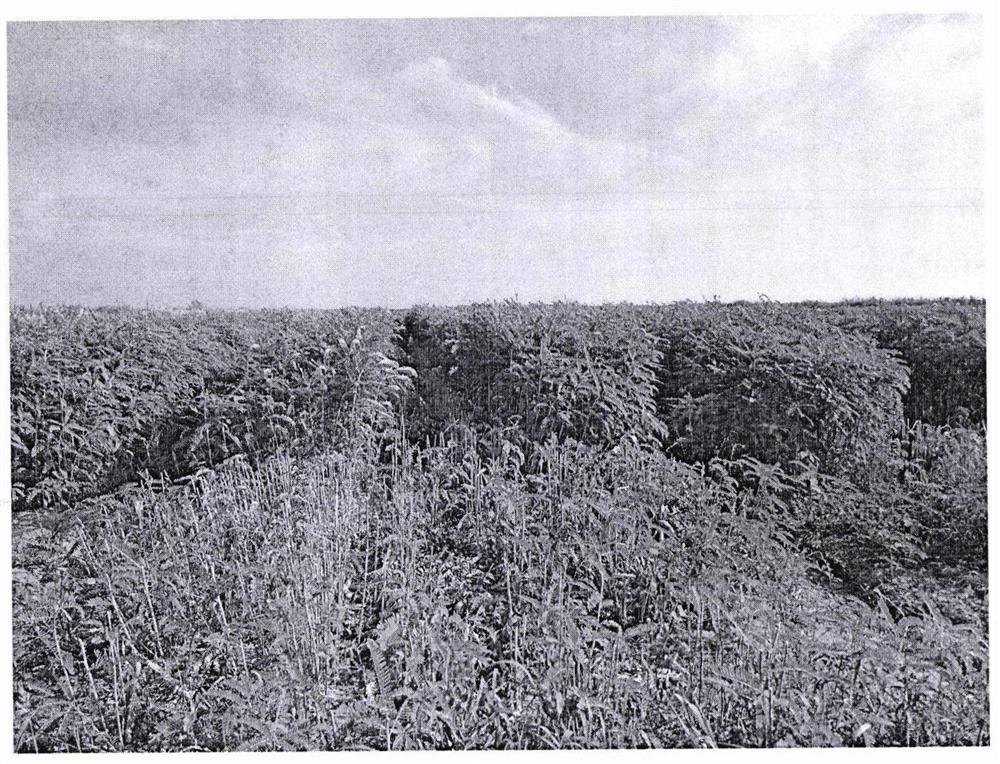Mud flat soil improvement method
A technology of soil improvement and tidal flats, which is applied in the field of plant cultivation, can solve the problems of long improvement time of single biological measures, low soil organic matter content, single microbial species, etc., and achieve good economy, improvement of soil quality, and improvement of soil physical and chemical properties.
- Summary
- Abstract
- Description
- Claims
- Application Information
AI Technical Summary
Problems solved by technology
Method used
Image
Examples
Embodiment 1
[0034] A method for improving tidal flat soil, comprising the steps of:
[0035] (1) Build cofferdams on the selected tidal flats to isolate the tidal flat soil from seawater; excavate drainage ditches on the cofferdams with a depth of 1.5-2m; An improved residential area, build ridges around the residential area, and the height of the ridge is 1-1.5m; excavate the saline-alkali soil on the surface of the improved residential area to 50cm, lay a straw layer, and lay biochar with a thickness of 10cm on the straw layer, and backfill the topsoil;
[0036] (2) Apply organic fertilizer in the improved plot, mix evenly, and then rotate tillage twice to form a plow layer, and mix it with earthworms;
[0037] (3) Cycling planting of vinaigrette and broad bean, planting vinaigrette in the first season, sowing at the right time in June of the first year, mowing in late July, laying the field flat, mechanical crushing and rotary plowing in late August; second season To plant broad beans...
Embodiment 2
[0049] The tidal flat selected in this example is located in Tiaozini Reclamation Area, Dongtai, Jiangsu Province. It is a muddy coast of silting type, coastal facies landform, flat terrain, subtropical humid monsoon climate, four distinct seasons, and precipitation mainly concentrates in June-August. Soil sample collection and soil quality analysis were carried out on the landform. The soil structure is extremely poor, the soil pH is 8.5-8.8, the organic matter content is 2.42g / kg, and the soil salt content in the 0-20cm plow layer is 0.4-1.0%. Suaeda salsa is dominant, with a coverage rate of less than 2%. High soil salinity and low soil organic matter content are the main obstacles to crop production in this tidal flat area.
[0050] Table 1 Soil aggregate content
[0051]
[0052] Table 2 Indexes of soil physical and chemical properties
[0053]
[0054] Use the following steps to transform the above tidal flat area, the steps are as follows:
[0055] (1) Build cof...
Embodiment 3
[0067] Select 9 tidal flats with similar environments to plant scallops, divide them into 3 groups, repeat 3 times in each group, the first group does not apply fertilizer before planting scallops, the second group uses ordinary farmyard manure, and the third group uses the organic fertilizer described in the present invention. Fertilizer, sowing in June, mowing in late July, paving the field, mechanical crushing and rotary plowing in late August; soil salt content and organic matter content in the three groups were measured in September, and the results are shown in Table 5.
[0068] Table 5 Soil salt content and organic matter content
[0069]
[0070] The above results show that applying the organic fertilizer of the present invention before planting can effectively promote the reduction of soil salt content in tidal flat areas and promote the accumulation of organic matter.
PUM
| Property | Measurement | Unit |
|---|---|---|
| thickness | aaaaa | aaaaa |
| density | aaaaa | aaaaa |
| thickness | aaaaa | aaaaa |
Abstract
Description
Claims
Application Information
 Login to View More
Login to View More - Generate Ideas
- Intellectual Property
- Life Sciences
- Materials
- Tech Scout
- Unparalleled Data Quality
- Higher Quality Content
- 60% Fewer Hallucinations
Browse by: Latest US Patents, China's latest patents, Technical Efficacy Thesaurus, Application Domain, Technology Topic, Popular Technical Reports.
© 2025 PatSnap. All rights reserved.Legal|Privacy policy|Modern Slavery Act Transparency Statement|Sitemap|About US| Contact US: help@patsnap.com



